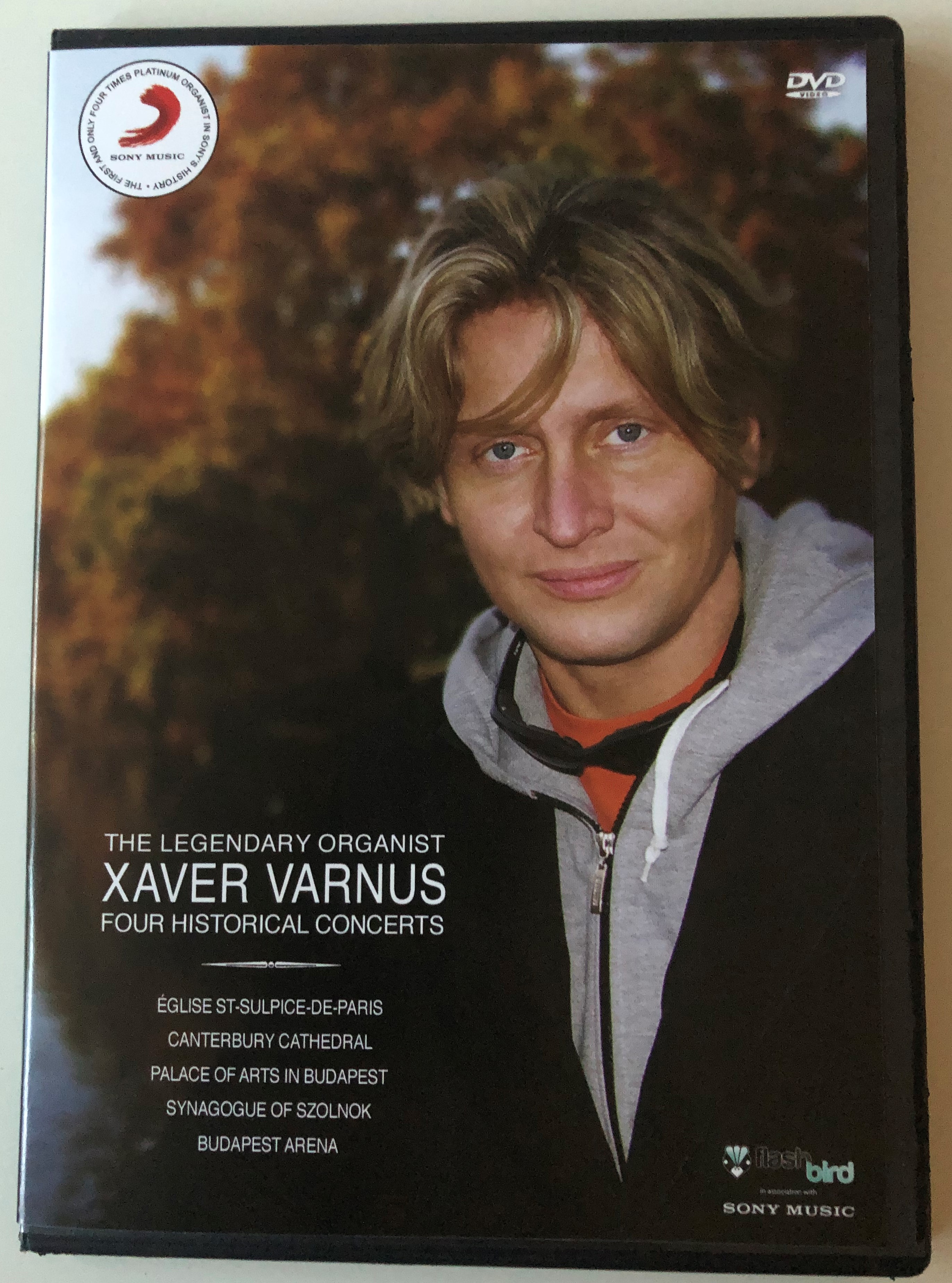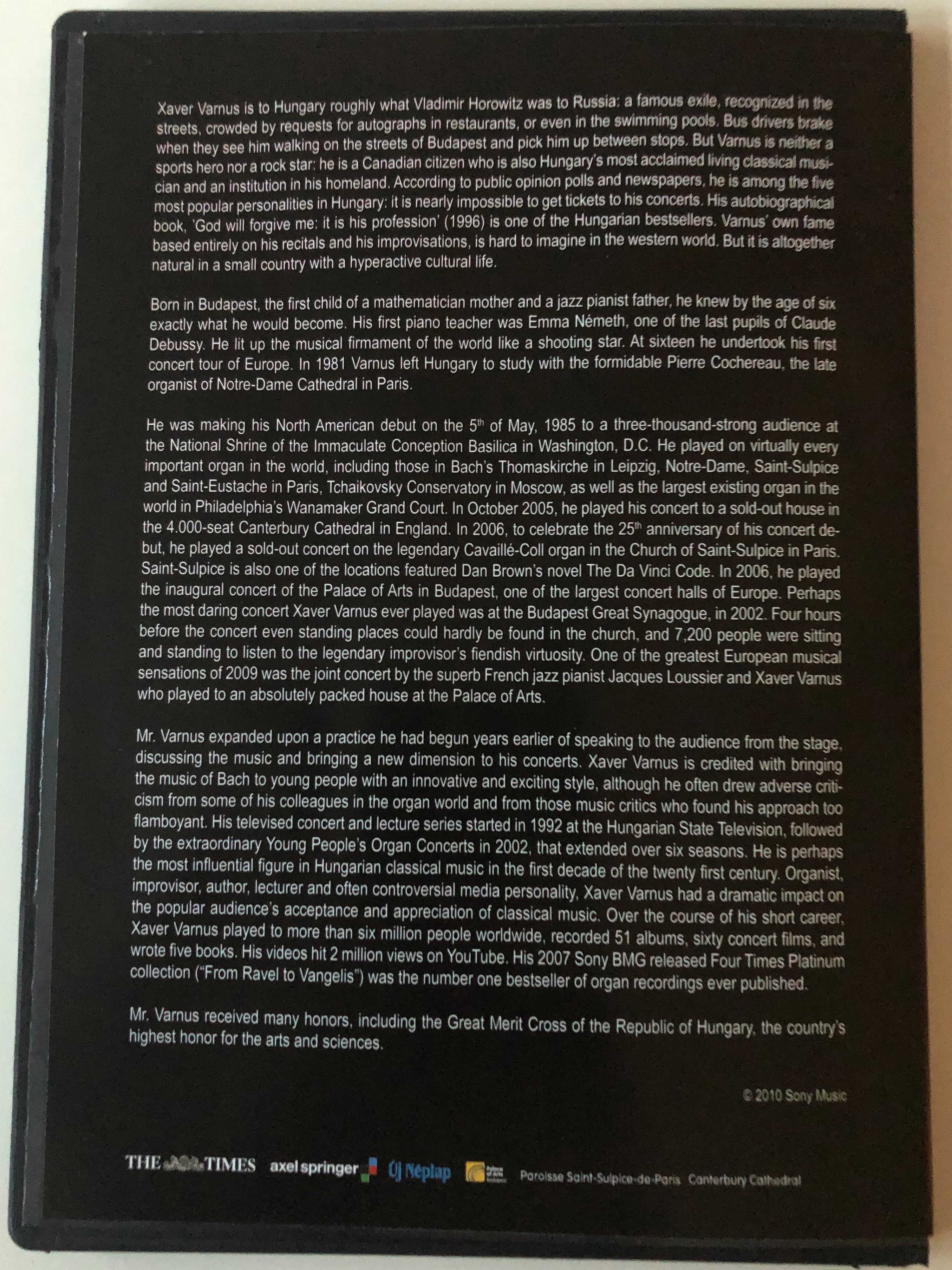Description
The Legendary Organist Xaver Varnus Five Historical Concert Portions DVD / Église Saint-Sulpice in Paris / Palace of Arts in Budapest / Synagogue Gallery of Szolnok / In the Canterbury Cathedral / Budapest Arena
Publisher: FlashBird release in association with Sony Music
Publication Date 2013
Total Playtime 2 hours and 16 minutes
REGION 0 PAL DVD (All regions)
UPC 5996514021158
IF you love ORGAN MUSIC, this DVD is for you!
Breathtaking concert footages featuring Xaver Varnus.
I.
Solo Recital on the legendary Cavaillé-Coll organ
Église Saint-Sulpice in Paris
October 23, 2006
J.S. Bach Praeludium c-moll
Cesar Franck Prelude, fugue et variations
Improvisation In memoriam 1956
II.
Solo Recital
Palace of Arts in Budapest
All Saints' Day 2010
Gabor Lisznyai-Szabo UNETANNEH TOKEF
Szilard Kovacs VARIATIONS ON A HUNGARIAN FOLK SONG
III.
Jazzy Bach Recital
Synagogue Gallery of Szolnok
With the participation of Jozsef Barcza-Horvath - double bass
Aron Lukacs - Guitar
Zsolt Toth - Percussion
November 17, 2012
J.S. Bach Air on G-string
J.S. Bach Jesu, Joy of Man's Desiring
J.S. Bach Tosccata and Fuge in D minor
IMPROVISATIONS on a Hungarian Folk Song
IV.
Solo Recital
In the Canterbury Cathedral
Canterbury Festival, 2004
IMPROVISATION on three themes
V.
All Bach-Jazz Recital
Budapest Arena
New Year's Eve, 2010
J.S. Bach Tosccata and Fuge in D minor
Arranged by Jacques Loussier and Laszlo Grunvald
FROM THE BACK COVER:
Xaver Varnus is to Hungary roughly what Vlasimir Horowitz was to Russia; a famous exile, recognized in the streets, crowded by requests for autographs in restaurants, or even in the swimming pools. Bus drivers brake when they see him walking on the streets of Budapest and pick him up between stops. But Varnus is neither a sports hero nor a rock star: he is a Canadian citizen who is also Hungary's most acclaimed living classical musician and an institution in his homeland. According to public opinion polls and newspapers, he is among the five most popular personalities in Hungary: it is nearly impossible to get tickets to his concerts. His autobiographical book, 'God will forgive me: it is his profession' (1996) is one of the Hungarian bestsellers. Varnus' own fame based entirely on hid recitals and his improvisations, is hard to imagine in the western world. But it is altogether natural in a small country with a hyperactive cultural life.
Born in Budapest, the first child of a mathematician mother and a jazz pianist father, he knew by the age of six exactly what he would become. His first piano teacher was Emma Nemeth, one of the last pupils of Claude Debussy. He lit up the musical firmament of the world like a shooting star. At sixteen he undertook his first concert tour of Europe. In 1981 Varnus left Hungary to study with the formidable Pierre Cochereau, the late organist of Notre-Dame Cathedral in Paris.
He was making his North American debut on the 5th of May, 1985 to a three-thousand-strong audience at the National Shrine of the Immaculate Conception Basilica in Washington, D.C. He played on virtually every important organ in the world, including those in Bach's Thomaskirche in Leipzig, Notre-Dame, Saint-Sulpice and Saint-Eustache in Paris, Tchaikovsky Conservatory in Moscow, as well as the largest existing organ in the world in Philidelphia's Wanamaker Grand Court. In October 2005, he played his concert to a sold-out house in the 4,000-seat Canterbury Cathedral in England. In 2006, to celebrate the 25th anniversary of his concert debut, he played a sold-out concert on the legendary Cavaille-Coll organ in the Church of Saint-Supice in Paris. Saint-Supice is also one of the locations featured Dan Brown's novel The Da Vinci Code. In 2006, he played the inaugural concert of the Palace of Arts in Budapest, one of the largest concert halls of Europe. Perhaps the most daring concert Xaver Varnus ever played was at the Budapest Great Synagogue, in 2002. Four hours before the concert even standing places could hardly be found in the church, and 7,200 people were sitting and standing to listen to the legendary improvisor's fiendish virtuosity. One of the greatest European musical sensations of 2009 was the joint concert by the superb French jazz pianist Loussier and Xavier Varnus who played to an absolutely packed house at the Palace of Arts.
Mr. Varnus expanded upon a practice he had begun years earlier of speaking to the audience from the stage, discussing the music and bringing a new dimension to his concerts. Xaver Varnus is credited with bringing the music of Bach to young people with an innovative and exciting style, although he often drew adverse criticism from some of his colleagues in the organ world and from those music critics who found his approach too flamboyant. His televised concert and lecture series started in 1992 at the Hungarian State Television, followed by the extraordinary Young People's Organ Concerts in 2002, that extended over six seasons. He is perhaps the most influential figure in Hungarian classical music in the first decade of the twenty first century. Organist, improvisor, author, lecturer, and often controversial media personality, Xaver Varnus had a dramatic impact on the popular audience's acceptance and appreciation of classical music. Over the course of his short career, Xaver Varnus played to more than six million people worldwide, recorded 51 albums, sixty concert films, and wrote five books. His videos hit 2 million views on YouTube. His 2007 Sony BMG released Four Times Platinum collection ("From Ravel to Vangelis") was the number one bestseller of organ recordings ever published.
Mr. Vanus received many honors, including the Great Merit Cross of the Republic of Hungary, the country's highest honor for the arts and sciences.
In 1981 Varnus left Hungary to study with the formidable Pierre Cochereau, the late organist of Notre-Dame Cathedral in Paris. He was making his North American debut on the 5" of May, 1989 to a three-thousand-strong audience the National Shrine of the Immaculate Conception Basilica in Washington, D.C. He played on virtually important organ in the world, including those in Bach’s Thomaskirche in Leipzig, and Saint-Eustache in Paris, Tchaikovsky Conservatory in Moscow, as well as the largest existing organ In the world in Philadelphia’s Wanamaker Grand Court. In October 2005, he played his concert to a sold-out house in the 4.000-seat Canterbury Cathedral in England. In 2006, to celebrate the 25" anniversary of his concert debut, he played a sold-out concert on the legendary Cavaillé-Coll organ in the Church of Saint-Sulpice in Paris. Saint-Sulpice is also one of the locations featured Dan Brown's novel The Da Vinci Code. In 2006, he played the inaugural concert of the Palace of Arts in Budapest, one of'the largest concert halls of Europe. Perhaps the most daring concert Xaver Varnus ever played was at the Budapest Great Synagogue, in 2002. Four hours before the concert even standing places could hardly be found in the church, and 7,200 people were sitting and standing to listen to the legendary improvisor’s fiendish virtuosity. One of the greatest European musical sensations of 2009 was the joint concert by the superb French jazz pianist Jacques Loussier and Xaver Varnus who played to an absolutely packed house at the Palace of Arts. Mr. Varnus expanded upon a practice he had begun years earlier of speaking to the audience from the stage, discussing the music and bringing a new dimension to his concerts. Xaver Varnus is credited with bringing the music of Bach to young people with an innovative and exciting style, although he often drew adverse criticism from some of his colleagues in the organ world and from those music critics who found his approach too flamboyant. His televised concert and lecture series started in 1992 at the Hungarian State Television, followed by the extraordinary Young People’s Organ Concerts in 2002, that extended over six seasons.
Interesting information:
Aristide Cavaillé-Coll (French: [aʁistid kavaje kɔl]; 4 February 1811 – 13 October 1899) was a French organ builder. He has the reputation of being the most distinguished organ builder of the 19th century. He pioneered innovations in the art and science of organ building that permeated throughout the profession and influenced the course of organ building and organ composing through the early 20th century. The organ reform movement sought to return organ building to a more Baroque style; but since the 1980s, Cavaillé-Coll's designs have come back into fashion. After Cavaillé-Coll's death, Charles Mutin maintained the business into the 20th century. Cavaillé-Coll was the author of many scientific journal articles and books on the organ in which he published the results of his researches and experiments. He was the inventor of several organ stops such as the flûte harmonique. His most famous organs in Paris are in Basilique du Sacré-Cœur, Basilique Sainte-Clotilde and Église de la Madeleine.
Église Saint-Sulpice / The Church of Saint-Sulpice is a Roman Catholic church in Paris, France, on the east side of Place Saint-Sulpice, in the Latin Quarter of the 6th arrondissement. It is only slightly smaller than Notre-Dame and thus the second largest church in the city. It is dedicated to Sulpitius the Pious.
























